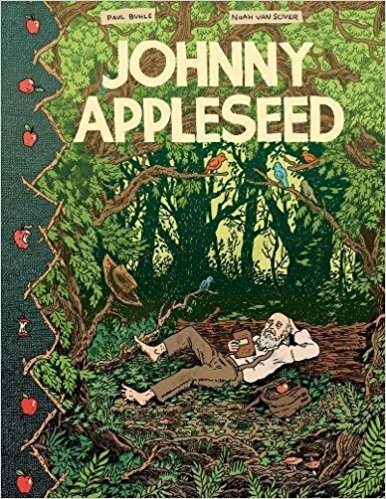Like cultures everywhere, the popular culture of United States includes numerous legends and fables that reflect the ideals and history of its people. From the logger Paul Bunyan to the trapper and hunter/military scout Daniel Boone; from Pecos Bill to Davy Crockett, the myths of the dominant culture reflect a history of Indian-killing, forest removal and a man tames nature sensibility. The tales of the oppressed cultures–especially native American, African-American and Latino–tend to create a myth where the trickster motif is the most prevalent. Perhaps this represents an implied understanding that the only way to survive against a warlike invader intent on domination is by outsmarting them. After all, If Brer Rabbit could convince Brer Fox to get tangled in the briarpatch to effect a getaway, that rabbit lives another day.
Along with the folk tales about Paul Bunyan and his ox ripping up forests from Maine to Washington State, there is an unusual folktale about another hero who planted trees instead of cutting them down. His name is Johnny Appleseed. More like St. Francis than Daniel Boone, Johnny Appleseed remains an unusual figure in the annals of US legends. A man of European descent, his intellectual and spiritual ancestors were, generally speaking, other settlers like the Massachusetts Bay Colony “heretic” Anne Hutchinson and the revelers whipped and belittled by John Winthrop’s Puritans in Nathaniel Hawthorne’s story “The Maypole at Merrymount.” Indeed, the real Johnny Appleseed’s given name was John Chapman. He was a believer in a form of primitive Christianity founded by a man named Swedenborg that derived his teachings in part from the radical Anabaptists, whose opposition to war and profit made them anathema to many traditional Protestant sects. These sects were more concerned with taming the earth than sharing it and did not dare conceive of an economy where food was given freely without some kind of monetary or other compensation in return. Johnny Appleseed defied these norms.
For those unfamiliar with the basics of Johnny Appleseed’s calling, here they are. He wandered unsettled and newly settled lands in what was then the westernmost part of the United States. In his wandering through the territories of what was mostly Ohio and Pennsylvania he planted the seeds of apple trees. Sometimes he planted these seeds on new farms being cleared by settlers, other times he planted the seeds in the wild. He interacted positively with Native American people throughout the territory he traveled and was considered an honorary member of some first nations. He followed the tenets of the aforementioned Anabaptist derivative and lived according to those tenets. All of this is laid out in a new graphic biography of Johnny Appleseed written by Paul Buhle and Noah van Scriver.
Besides providing a story of Chapman’s life, the authors also present the basics of his belief system, which derived from an obscure protestant sect known as the Swedenborgians. In the process of explaining the beliefs of the Swedenborgians, the reader discovers another piece of US alternative history. It is a history often ignored and explained away in favor of the bellicose and patriarchal story that informs most of US politics and culture. This is the history of the bohemians and dreamers, the pacifists and the naturalists; the hippies and the beats. Searchers for a better life free of greed and conflict, this phenomenon is an ongoing part of human history. Its occurrence in the history of the United States begins with its indigenous peoples and, after the Europeans occupied the land, was assumed by some of the new inhabitants, too. Johnny Appleseed remains not just as an example of this alternative way of life, he was one of the few such Americans whom the indigenous people actually respected.
Van Scriver’s drawings are perfect for the subject of this book. Intricate yet rustic, the artwork represents the natural landscapes of the nineteenth century North American Midwest in both artistic and spiritual terms. Simultaneously simple and detailed, each drawn frame is a window into the woods, meadows, and small settlements Johnny Appleseed traversed in his decades of wandering. The lines are never quite straight, just like the tale of Appleseed himself. The combination of Van Scriver’s art and Buhle’s story makes this particular telling of the tale of Johnny Appleseed one of the best.